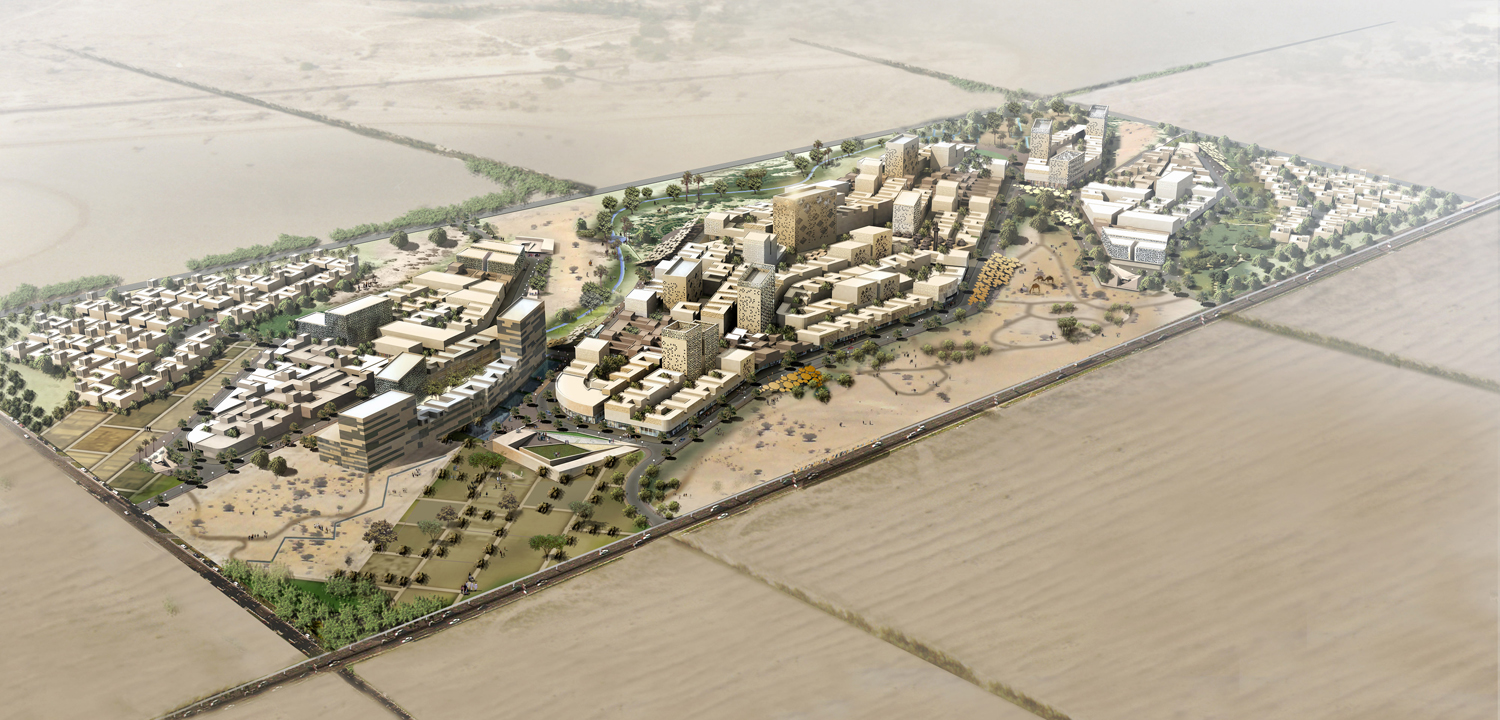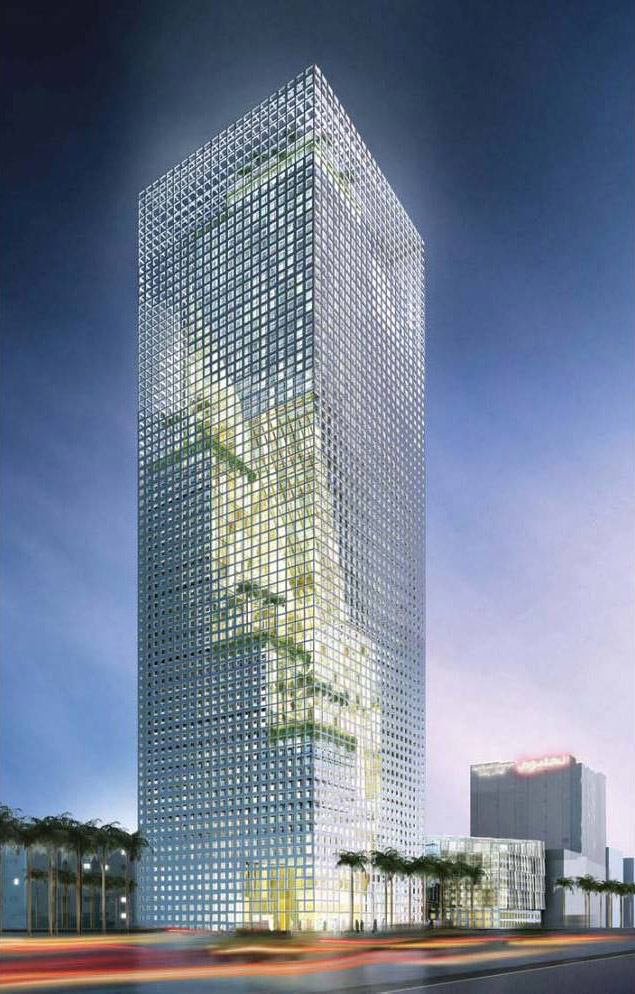|
|
Karim Elgendy
Throughout the last three decades, the city of Dubai has not been known for its emphasis on sustainability as guiding principles for its development. Not only did it adopt an unnatural rate of growth by middle eastern and global standards, it has also long disregarded the environmental and social consequences of its rapid urbanization. Dubai’s growth relied on -and was economically fueled by- a development model which imported inappropriate and inefficient building forms and planted them in its extreme climate. The result was a 1,500 square miles city (3,885 square kilometers) with isolated island buildings that are not only divorced from their environments, but which also require a great amount of fossil fuel energy to remain habitable.
 Image 1. Aerial View of Xeritown showing massing and landscaping. Copyrights: X-Architects and SMAQ The city of Dubai also has one of the highest carbon footprints per capita in the world, and even though this footprint is partially a result of energy intensive water desalination processes on which the city relies for its potable water, Dubai’s carbon footprint remains higher than that of other gulf cities including Saudi cities which also rely greatly on desalination.
In many ways, it is fair to argue that the Dubai’s model of development has been, in essence, the antithesis of sustainable development over the last three decades. In other words, Dubai has come to represent the climax of an obsolete development model in which humans attempted to subjugate their environment rather than coexist with it.
In contrast to this un-sustainable development pattern, Dubai’s neighboring city of Abu Dhabi has long adopted a measured and less extravagant development model. Over the same three decades, Abu Dhabi’s development model was generally characterized with a more sustainable pace of development. In the last few years, Abu Dhabi has been attempting to champion sustainable development in the Middle East by establishing a sustainability oriented framework for its development over the next 20 years, and by establishing the Masdar initiative which includes the world’s most progressive sustainable city project at its outskirts with ambitious zero-energy and zero-waste targets.
Continue reading Dubai Experiments with Sustainable Development
Karim Elgendy
In late 2008 the French President Francois Sarkozy inaugurated a new French school in Damascus, Syria. The French school, known as Lycée Charles de Gaulle, follows the french educational system and is accreddited by the French ministry of education. The school was designed by the French architects Ateliers Lion together with the German environmental engineering firm, Transsolar.
 Image 1. Night view of school central courtyard showing the solar chimneys. Copyrights: Adria Goula Sarda, Ateliers Lion The brief for the design team was to to develop a campus for the school with a capacity for 900 students ranging from kindergarten to high school. The design team was also tasked to develop a campus that embodies sustainability by using low-technology solutions for ventilation and conditioning of the school spaces, while maintaining the thermal comfort levels required for students in an educational environment.
Continue reading A Damascus School Revives Traditional Cooling Techniques
Karim Elgendy
As previously reported on Carboun, Masdar City – the $22 billion project of the Abu Dhabi Future Energy Company (Masdar) – is currently under construction and is due to be completed in 2016. As the the first zero-carbon emissions and zero-waste city, the master plan for Masdar City integrates many passive design and planning strategies with renewable energy production to achieve its ambitious sustainability goals.
At the center of Masdar City lies its first building, the Masdar Headquarters, which will become the new home of Abu Dhabi’s Future Energy Company, as well as the secretariat of the International Renewable Energy Agency (IRENA). The building – together with other key building -will act as an anchor and a catalyst for the development of the city.
 Image 1. Rendering of Masdar HQ. Copyrights: Adrian Smith+ Gordon Gill
Continue reading Abu Dhabi’s Masdar Headquarters: The First Positive-Energy Building in the Middle East
 Image 1. A night view of the design showing the shading envelope and the spiraling forms behind. Copyrights: Perkins+Will In February 2010, the design for Al-Birr Foundation Headquarters in Riyadh, Saudi Arabia, has been named as the winner of the 2010 Architectural Review / MIPIM Future Projects Awards under the ‘tall buildings’ category (Image 1). The unbuilt project, designed by Perkins+Will’s New York Office, was commissioned for Al-Birr Foundation, a non-profit organization aimed at alleviating poverty and caring for disadvantaged families and children.
The Design
Of the many features of the design of the 59, 000 sqm tower, perhaps the most interesting is how it was concieved as a sustainable urban tower that responds to the environmental characteristics and the microclimate of the city of Riyadh, which is a challenging climate to address given the extreme solar exposure and the heat conditions of Riyadh.
Faced with these climatic conditions and a deep plot of 1000 x 1200m, the projects’s designers response was to rethink the high rise typology in this context. The design’s most visible response to the climate is the building’s envelope which was designed as a large rectangular frame of brise-soleil enclosing the occupied parts of the building. This shading frame was designed to respond to both the different amounts of solar radiation received by each elevation as well as the interior spaces behind it. To achieve this result, a mapped shading mesh was devised to provide varying levels of openness for different locations of the different elevations depending on its solar exposure and its spatial/contextual influences. The result was an envelope that resembles a mesh of varying densities surrounding the building and simultaneously protecting and revealing the activities behind it.
This proposed design solution thus helps the building reduce its solar heat gain while maintaining its views towards the city (FIgure 1). In addition to this shading effect, the mesh-like dynamic treatment of the envelope has also helped animate the building’s expression with the dense and sparse zones of the facade adding a dynamic effect to what otherwise may have become a static pure form.
Continue reading Riyadh Tower Design adapts a Traditional Middle Eastern Shading Strategy
 Masdar City Masterplan. Copyright Masdar, Foster+Partners When Masdar City was first announced in 2007 by the Masdar Initiative, it claims that, when completed, it will become the world’s first zero carbon, zero waste development, while maintaining the highest quality of living. Foster + Partners and a team of environmental consultants including WSP and Transsolar have been appointed by Masdar to design the masterplan and the first stage of the project which broke ground in February 2008.
Masdar City’s Master plan is claimed to “meet and exceed” the principals of One Planet Living (OPL), a set of ten guiding principles of sustainability, proposed in a joint initiative by WWF, the global conservation organization and Bioregional Development, whereby everyone lives within their fair share of the Earth’s resources. The principles include Zero Carbon, Zero Waste, Sustainable transport, Sustainable materials, Sustainable water, and Sustainable culture and heritage.
The project also comes in the context of a rapidly increasing population and an economic boom in Abu Dhabi which -, together with new laws opening the emirate’s real estate to the free market- led to speculation and a housing shortage estimated in 2008 to between 35,000 and 50,000 dwelling units. This shortage has prompted the state to allocate billions for the construction of residential buildings, especially for foreign workers and western expatriates. This housing shortage has also resulted in rising house prices, which led to discussion of legislations that would introduce a 20 per cent quota for low-income housing in future developments.
Continue reading Masdar City Masterplan Reviewed
|
|





